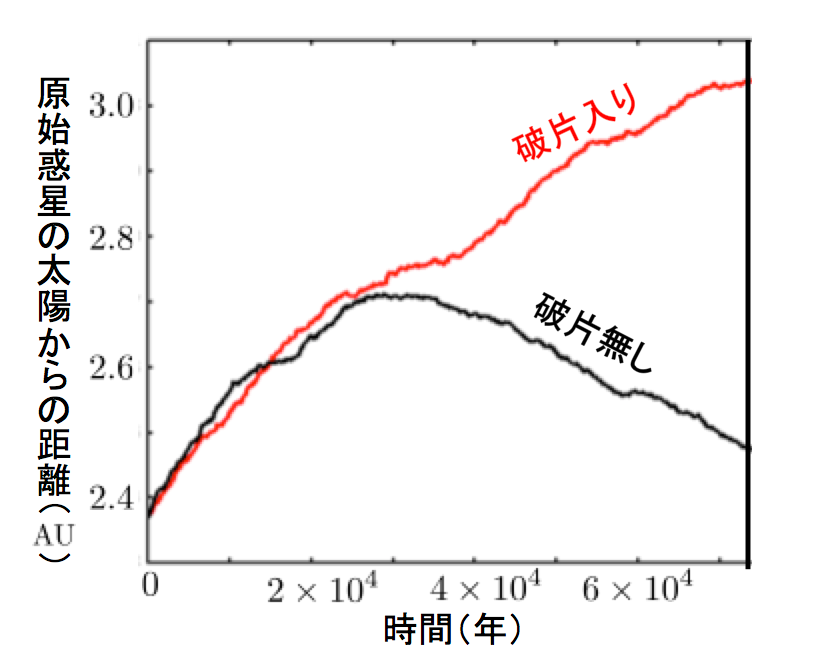High Resolution N-body Simulation of Planet Accretion: Effect of Fragmentation onto Planetesimal Accretion
JAXA Supercomputer System Annual Report April 2017-March 2018
Report Number: R17EACA27
Subject Category: JSS2 Inter-University Research
- Responsible Representative: Junko Kominami, Tokyo Institute of Technology
- Contact Information: Junko Kominami kominami@mail.jmlab.jp
- Members: Junko Kominami
Abstract
When the Sun was formed, protoplanatary disk was formed. It is widely accepted that planets are formed through the coagulation of dust component in the protoplanetary disk. However, the Jovian planets and icy planets were formed can not be explained using classical planet formation. For example, protoplanets are thought to fall into the central star before they grow to the size of the Earth.
Our group are carrying out N-body simulation to investigate the planet formation process.
In this study, we use the code called “Kninja” which is adopted to JSS2 system, including gas drag, type-I migration and collisional fragmentation.
The aim of the study in this fiscal year is to see how the planet formation stage changes if the above effects are included.
Reference URL
N/A
Reasons for using JSS2
Originally, Kninja was developed on K-computer. However, in order to obtain enough scientific results, the computational time was not enough.
In addition, SORA-MA of JSS2 system has higher performance.
Achievements of the Year
In the past N-body simulations, when the collision takes place, two colliding bodies merge and form one new body (perfect accretion assumption). This treatment has been incorporated not to increase the number of bodies. Increase of the bodies leads to long simulation time. If perfect accretion is assumed, as the planetesimals grow, the number of the bodies decreases. This assumption let us able to set the initial number of the bodies to be large. However, fragments affects the protoplanet’s and planetesimals’ random velocity due to their dynamical friction, and have significant effect onto the planet accretion stage. Hence, it is crucial to include the effect of fragmentation into the N-body simulation.
When the fragmentation is included in the simulation, large number off small fragments are produced. The gas drag damps the random velocity of the fragments or small planetesimals. Such small planetesimals with small random velocity may enhance the planetesimal driven migration (PDM). This PDM can carry the protoplanet toward the outer region of the disk. In such case, inward type-I migration may be overcome.
In our study, the gas drag, type-I migration and fragmentation are included in our large scale N-body simulation. By doing so, we investigated the migration of the protoplanet was surrounded by small planetesimals with small random velocity. These small planetesimals helped the protoplanet move outward (due to PDM) in the disk more smoothly than in the cases only with large planetesimals.

Fig.1: Time evolution of the protoplanet’s semimajor axis. When the fragmentation is considered, the outward migration continues.
Publications
■ Presentations
1) Junko Kominami, “High resolution global N-body simulation of planet formation with fragmentation”, JpGU, Makuhari
2) Junko Kominami, “Formation of planets using large scale N-body simulations”, Post K computer Embryotic Research WS
3) Junko Kominami, “Clarifying the planet formation process with simulations”, Frontier of Astronomy WS
4) Junko Kominami, “High resolution global N-body simulation of planet formation with fragmentation”, Japan Astronomical Society
■ URLs for the Research Results on the Web
1) http://www.hpci-office.jp/pages/k-san_cu18
Usage of JSS2
Computational Information
- Process Parallelization Methods: MPI
- Thread Parallelization Methods: OpenMP
- Number of Processes: 2 – 32
- Elapsed Time per Case: 96.00 hours
Resources Used
Fraction of Usage in Total Resources*1(%): 0.19
Details
Please refer to System Configuration of JSS2 for the system configuration and major specifications of JSS2.
| System Name | Amount of Core Time(core x hours) | Fraction of Usage*2(%) |
|---|---|---|
| SORA-MA | 1,587,491.68 | 0.21 |
| SORA-PP | 0.00 | 0.00 |
| SORA-LM | 0.00 | 0.00 |
| SORA-TPP | 0.00 | 0.00 |
| File System Name | Storage Assigned(GiB) | Fraction of Usage*2(%) |
|---|---|---|
| /home | 004.77 | 0.00 |
| /data | 047.68 | 0.00 |
| /ltmp | 976.56 | 0.07 |
| Archiver Name | Storage Used(TiB) | Fraction of Usage*2(%) |
|---|---|---|
| J-SPACE | 0.00 | 0.00 |
*1: Fraction of Usage in Total Resources: Weighted average of three resource types (Computing, File System, and Archiver).
*2: Fraction of Usage:Percentage of usage relative to each resource used in one year.
JAXA Supercomputer System Annual Report April 2017-March 2018


